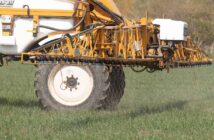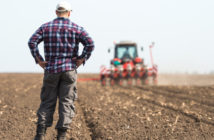Bayer had a very successful year in 2016, both strategically and operationally. “We again posted a record operating performance – and are making good progress with the agreed acquisition of Monsanto as well,” Management Board Chairman Werner Baumann said on Wednesday at the Financial News Conference in Leverkusen. Pharmaceuticals once again posted encouraging sales and earnings growth. Consumer Health recorded sales growth on a currency- and portfolio-adjusted basis (Fx & portfolio adj.), while earnings were down. At Crop Science, currency- and portfolio-adjusted sales and clean EBITDA remained steady despite the persistently difficult market environment. Animal Health posted currency- and portfolio-adjusted sales growth, while earnings were on a par with the prior-year level. Covestro raised earnings sharply, while sales attained the prior-year level after adjustment for currency and portfolio effects. “We have every reason to be optimistic about the future and started the new business year well,” said Baumann. He raised the prospect of further growth in sales and earnings in 2017.
Bayer last year took a major strategic step forward with the agreed acquisition of Monsanto, said Baumann. “This transaction is the perfect fit for our strategy of seeking leadership positions with our Life Science activities in attractive, innovation-driven markets.” Once the businesses have been combined, Bayer would be able to create substantial additional value in the long term through more innovation, stronger growth and greater efficiency. At a special meeting in December 2016, Monsanto’s stockholders approved the transaction. Bayer has also made progress in the necessary antitrust proceedings and has already applied for clearance from some two-thirds of around 30 authorities. Bayer and Monsanto are working closely with the authorities. Bayer remains confident of closing the transaction before the end of 2017.
Sales of the Bayer Group increased in 2016 by 1.5 percent (Fx & portfolio adj. 3.5 percent) to EUR 46,769 million (2015: EUR 46,085 million). EBITDA before special items advanced by 10.2 percent to EUR 11,302 million (2015: EUR 10,256 million). EBIT rose by 12.8 percent to EUR 7,042 million (2015: EUR 6,241 million) after special charges of EUR 1,088 million (2015: EUR 819 million). These resulted mainly from impairment losses on intangible assets, charges in connection with efficiency improvement programs and costs for the integration of acquired businesses. EBIT before special items climbed by 15.2 percent to EUR 8,130 million (2015: EUR 7,060 million). Net income improved by 10.2 percent to EUR 4,531 million (2015: EUR 4,110 million), and core earnings per share from continuing operations by 7.3 percent to EUR 7.32 (2015: EUR 6.82).
Operating cash flow from continuing operations climbed by 20.8 percent to EUR 8,259 million (2015: EUR 6,836 million). “Here we benefited mainly from the improved earnings situation and a decrease in additional cash tied up in net current assets,” explained CFO Johannes Dietsch. Net financial debt declined by 32.5 percent in 2016, to EUR 11.8 billion. Cash inflows from operating activities and the issuance of mandatory convertible notes were set against cash outflows for dividends and negative currency effects.
Crop Science successful in a difficult market environment
In the agriculture business, Bayer posted sales of EUR 9,915 million (2015: EUR 10,128 million; Fx & portfolio adj. plus 0.1 percent). “The market environment for our Crop Science Division remained weak last year, particularly in Latin America,” said Baumann. Crop Science nonetheless held sales at the prior-year level, the Bayer CEO explained. The considerable 6.9 percent (Fx adj.) decline in Latin America was compensated by gains in the other regions. Sales rose by 3.9 percent (Fx adj.) in North America, 2.7 percent (Fx adj.) in Asia/Pacific and 1.8 percent (Fx adj.) in Europe/Middle East/Africa.
Seeds (seeds and traits) in particular developed positively, growing by 8.3 percent (Fx & portfolio adj.). The Crop Protection business posted gains of 4.0 percent for Fungicides and 4.1 percent for SeedGrowth (seed treatment products) on a currency- and portfolio-adjusted basis. By contrast, the Insecticides business was down sharply (Fx & portfolio adj. minus 13.3 percent). At Herbicides, sales declined slightly (Fx & portfolio adj. minus 2.2 percent). Environmental Science registered a sales gain of 4.5 percent (Fx & portfolio adj.).
EBITDA before special items of Crop Science came in level with the previous year (plus 0.6 percent) at EUR 2,421 million (2015: EUR 2,406 million). A positive currency effect of about EUR 140 million and higher selling prices were offset by lower volumes, higher research and development expenses and higher impairment losses on receivables.
Good progress in financing the agreed acquisition of Monsanto
Bayer is also making good progress with refinancing the agreed acquisition of Monsanto, continued Dietsch. The company has successfully implemented both the acquisition financing of USD 57 billion and the first equity measure in the amount of EUR 4 billion. “Transactions of this magnitude don’t necessarily go smoothly. The fact that we were so successful in these financing activities is also evidence of Bayer’s good reputation in the capital markets,” remarked Dietsch. Further refinancing of the acquisition financing is planned to include corporate and hybrid bonds and the raising of additional equity via a rights issue. However, should Bayer identify options to further optimize financing structures, instruments and also the timing of financing steps in the context of the transaction, the company will consider these.
“Innovation is our core competence”
Innovation is the foundation of Bayer’s success, Baumann explained. “It is our core competence.” He said the company is therefore investing substantially in strengthening its innovation capability. Last year Bayer spent nearly EUR 4.7 billion on research and development (plus 9.2 percent). “In the Life Science businesses, research and development expenditures amounted to EUR 4.4 billion, which was nearly 13 percent of sales. This, too, is an all-time record for Bayer,” said Baumann. “These efforts to further strengthen our innovation capability are paying off, as we can see in our development pipelines.” At Pharmaceuticals, for example, Bayer has a whole series of promising product candidates currently undergoing clinical development. The company estimates that six of them – in the mid- to late-stage pipeline – have an estimated combined peak annual sales potential of at least EUR 6 billion. At Crop Science, the combined peak annual sales potential of Bayer’s crop protection and seed technology pipeline is estimated at more than EUR 5 billion from products that have been or will be brought to market between 2015 and 2020.
Positive development expected to continue in 2017
“We expect the positive development to continue in fiscal 2017,” said Baumann. Sales of the Bayer Group including Covestro are targeted to increase to more than EUR 49 billion. This corresponds to a low- to mid-single-digit percentage increase on a currency- and portfolio-adjusted basis. EBITDA before special items is forecast to grow by a mid-single-digit percentage. The company aims to increase core earnings per share from continuing operations by a mid-single-digit percentage as well. It should be noted that only 64 percent of Covestro will be reflected for the full year 2017. Also reflected are the mandatory convertible notes that were successfully issued in November 2016, which increased the weighted average number of shares. These forecasts are based on exchange rates as of December 31, 2016, including a rate of USD 1.05 to the euro.
Crop Science is predicting sales of more than EUR 10 billion. This corresponds to a low-single-digit percentage increase on a currency- and portfolio-adjusted basis. EBITDA before special items is expected to come in on the level of the prior year.



